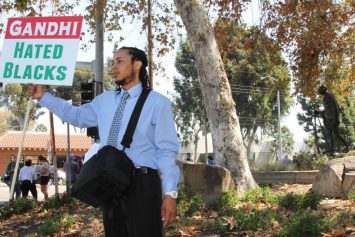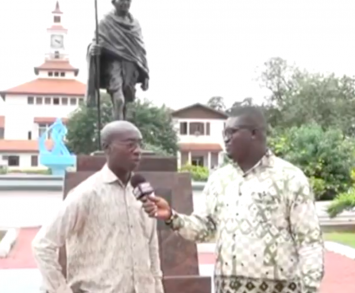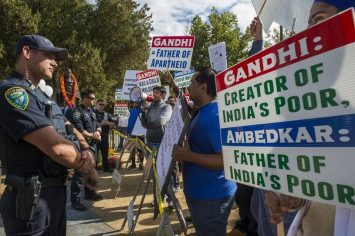OTTAWA, Canada—The statue of Mohandas Gandhi at Carleton University in Ottawa has been controversial since its installation in 2011, but the controversy recently reignited as student bodies began demanding its removal.
“Remove the Gandhi statue,” states Kenneth Aliu, a leading voice in the campaign at Carleton University. Aliu, who is president of the Institute of African Studies Student Association (IASSA), writes, “Gandhi was a racist. He utilised anti-Black racism as a weapon to bargain with the British about the subjugation of Indians living in South Africa. Instead of a pacifist liberator, he actually furthered the entrenchment of the caste system in India as well.”



When the statue was unveiled on October 2, 2011, then-High Commissioner for India to Canada Shashishekhar Gavai declared, “Gandhi is the greatest man of all time.” Speaking to Carleton University’s student newspaper before the unveiling, however, Organization for Minorities of India (OFMI) spokesperson Arvin Valmuci remarked, “I’m really kind of shocked that the university would even consider installing a statue of someone who… supported segregation in South Africa before apartheid [and] worked to create a Hindu India, not a secular country.” Connor Oke, reporting in Vice.com on recent student opposition to the statue, explains that “a growing number of critics say, despite his admirable reputation, Gandhi was also a misogynist, a racist towards black Africans, and a supporter of the caste system in India.”
“Gandhi is popularly known as a leader of India’s movement for independence from the British Empire, but before that he spent 21 years living and working as an attorney in South Africa,” remarks Pieter Friedrich. An analyst of South Asian affairs, Friedrich explains, “Before the dawn of the 21st century, little scholarship existed which critically examined Gandhi’s activities in Africa. Digitization of his voluminous writings made it possible to efficiently examine them from a skeptical angle and establish how openly racist he was towards Africans.”
Other student leaders at Carleton have joined Aliu’s call to topple the statue. Sheldon Paul, vice-president of the Malayalee Student Association of Carleton, writes, “As my friend Kenneth highlights, Gandhi’s controversial views on race from his time in South Africa… have cast darkness on that deified legacy.”
Detailing some of Gandhi’s views, Aliu notes, “He was known to explicitly refer to Black South Africans as ‘Kaffir,’ a derogatory term on the same level as the N-word.” Aliu additionally points out that Gandhi “advocated for further segregation between people of colour” and “portrayed Africans as savages.” Aliu suggests Gandhi was “collectively placed on a moral pedestal” because of “his proximity to whiteness as one who continually espoused anti-Black rhetoric.” In conclusion, he argues, “The removal of the statue is one way of correcting that history and rethinking the narratives we tell.”
Jada Bernard, an African activist who has repeatedly spoken out about Gandhi’s racism, applauds Aliu’s efforts. Bernard recalls joining a 2013 protest for removal of a Gandhi statue in Cerritos, California, where he held a “Gandhi Hated Blacks” placard. “We don’t hate Gandhi,” remarks Bernard. “We love the truth. But truth telling sounds hateful to those comforted by lies. We only wish to bless our children with accurate history.”



Bernard’s activism was followed in 2016 by a vigorous campaign against a Gandhi statue in the West African nation of Ghana. During an official visit in June 2016, the President of India unveiled a statue of Gandhi on the University of Ghana campus. As reported by Time magazine, however, “professors and students at the University of Ghana called the statue ‘a slap in the face’ because of Gandhi’s ‘racist identity.’” After a vigorous campaign which received extensive international coverage, the protestors achieved an agreement — which has yet to be fulfilled — for removal of the statue. Their achievement inspired Kenneth Aliu to attempt similar action to remove the Carleton University Gandhi statue.
In a lengthy statement provided to OFMI, the Ghanaian faculty who led the 2016 campaign offer words of encouragement to the efforts of Carleton University students. “We salute and solidarise with all movements fighting against this infliction of double pain on Afrikan=Black peoples,” states the group. Describing themselves as the #GandhiMustFallGhana Coalition, the group includes Dr. Ọbádélé Kambon, Dr. Kwadwo Appiagyei-Atua, and Prof. Akosua Adomako Ampofo. According to their full statement,
Mohandas Karamchand Gandhi (a.k.a Mahatma), who thought Kaffir and Afrikan were synonyms, was able to con his way into the hearts of many, including notable Black men from Kwame Nkrumah, Martin Luther King, Jr., to Nelson Mandela by intentionally “hiding” the truth about who he really was through “impropagandhi.” It may surprise some that Gandhi – through his words and/or deeds – supported every major war in his lifetime, including the Second Boer War (1899-1902), the Bambatha Rebellion (1906), World War I (1914-1918) and World War II (1939-1945). In the Bambatha rebellion, he campaigned vehemently for the violent repression of the Zulus. In Umzantsi Afrika (South Afrika), he played a central role in the caste-like segregation of the Durban Post and Telegraph Offices. Later in life, Gandhi continued to oppose the aspirations of Blacks in India through his vigorous campaign against the Communal Award designed to free Dalits and other oppressed Blacks from the yoke of Indo-Aryan oppression.
Today in India, home of this supposed doyen of non-violence, Afrikan=Black people and people of Afrikan=Black descent, including the Dalits, Dravidians, Siddis, etc., are constantly discriminated against on the grounds of caste and/or race and denied the status of citizenship or simply as human beings. Some are mobbed, beaten, and killed in broad daylight. Yet, the Modi government has sought to propagate and perpetuate “impropagandhi” by propping statues of this colossal anti-Black pro-Indo-Aryan Gandhi all over the world through “Modiplomacy.” Doing so is tantamount to advocating for the fork-tongued hypocrisy of a pathological liar and does a disservice to humanity in general and Afrikan=Black people in particular.
Bhajan Singh, Founding Director of OFMI, explains, “India’s Prime Minister, Narendra Modi, uses Gandhi as the foundation of his Modiplomacy. After architecting a genocide of minorities in 2002 while serving as Chief Minister of Gujarat, he whitewashed his record as the Butcher of Gujarat by cloaking himself with the fabricated legacy of the world’s most famous Gujarati — Gandhi.” Singh points to Modi’s remarks on October 2, 2017, made in honor of Gandhi’s birthday, when the Prime Minister stated, “I bow to beloved Bapu on Gandhi Jayanti. His noble ideals motivate millions across the world.” Singh, who has participated in several demonstrations against Gandhi statues, further comments, “Gandhi’s use as a cloak to conceal the crimes of the Indian State is one factor motivating us to expose the so-called Mahatma as a fraud.”



One of the earliest protests against a Gandhi statue was in Johannesburg, South Africa in 2003. Since then, a wave of protests has erupted on at least three continents. Some of the protests include: 2010 in Flint, Michigan and in San Francisco, California; 2011 in Ottawa; 2013 in Cerritos, California and in Fresno, California; 2015 in Johannesburg; 2016 in Davis, California; and 2017 in Ghana.
Suthamalli Ganga, a member of the Ambedkar Association of North America, was involved in protests in Michigan. “We once gave a big list to a mayor of Lansing where the Indians have put up a Gandhi statue,” remarks Ganga. Linking Gandhi’s views on race in South Africa to his views on caste in India, he says, “Gandhi abused Africans in derogatory terms and continued this abuse as a follower of caste-imbued Hinduism. He was a crooked man who always stood against Dalit freedom from casteist Hindus and, most importantly, always against the greatest Indian, Dr. Ambedkar, who stood for righteous freedom for Dalits from the Hindu patriarchy and barbarism imposed by religious texts like Manusmriti.”
Dr. Bhim Rao Ambedkar is frequently contrasted with Gandhi in the controversy surrounding these statues. Aliu, for instance, writes, “Gandhi’s anti-Black racism equaled his support of an entrenched caste system, one others vehemently campaigned against, like the anti-caste activist B.R. Ambedkar in his still radical text, Annihilation of the Caste.” At the protest in Davis, demonstrators displayed placards reading, “Gandhi: Creator of India’s Poor; Ambedkar: Father of India’s Poor.” When OFMI protested a statue in San Francisco, The San Francisco Chronicle reported that demonstrators asked for it to be “replaced with one of either Martin Luther King Jr. or low-caste Dalit leader B.R. Ambedkar.”



“Ambedkar was the Dr. Martin Luther King, Jr. of India,” says Friedrich. “He was born as a so-called Untouchable — an outcaste or Dalit. We wouldn’t present a white man as the spokesperson of the African-American struggle, but that’s what happened in India. Ambedkar’s true place as the champion of the Dalits has been usurped through decades of propaganda which portray the upper-caste Gandhi as the representative of the outcastes.”
Over the past two years, opposition has mounted to monuments on public property in the United States which memorialize the Confederate States of America. According to The Los Angeles Times, “Cities across the country have yanked dozens of Confederate monuments. Black politicians and activists have been among the strongest supporters of the removals.”
Opponents of Gandhi statues see a strong parallel to the movement against Confederate monuments. For instance, one year after the City of Davis installed a Gandhi statue, Friedrich attended a city council meeting to contrast the campaigns. “Removing statues glorifying people who participated in a war to preserve slavery seems like a good idea,” Friedrich told the city council on Oct. 2, 2017. “These Confederates, of course, were all Americans — Lee was from Virginia. So when we are removing statues of racist Americans, why are we installing statues of racist non-Americans?”
Bernard, who describes Gandhi statues as “propagandhi,” also parallels the campaigns. “Of the many gears of war, propaganda seems most dangerous, since its power lies in subtlety, conditioning, and deception,” remarks Bernard. “The symbols are usually apocryphal, with hidden meanings. These statues are falling because the veil has been removed and their hidden agenda exposed. They were not a monument to Confederate heroes, but to a social condition the Negro should constantly be reminded of.”





If blacks do not like a Gandhi Statue in Canada then they can always go to another country or another place, but to tell the Canadians they should take down something of history is outrageous and racist! Winston Churchill was racist too but he was seen as a real hero in Britain. These were men of their times they were tough etc and etc, let us not forget mandella he was a terrorist part of the anc, we should be taking his statue down as well as martin luther kings and sent them to africa where they belong, I wonder what blacks would say about that!!!
With this we have forgotten the other phases of Mr. Gandhi.
very well written, only thing missing was his sexual exploits.He was also responsible for the butchery of millions of human beings mostly Sikhs and Muslims .
No he was not! Gandhi was a figurehead of his time just as Churchill and mandella were, if a this lot take down Gandhi then the likes of mandella, who was part of the anc should also be taken down in the western world as well as martin luther king! This is about race wars you should be standing up FOR Gandhi statue which identifies where your family came from!